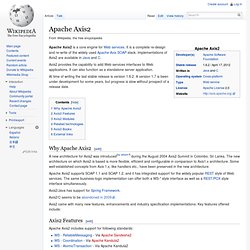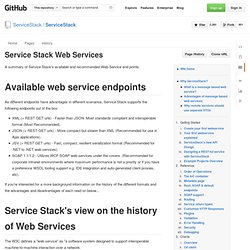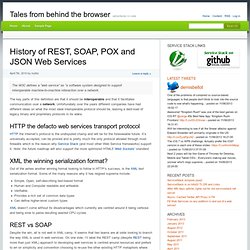

Apache Axis2. Axis2 provides the capability to add Web services interfaces to Web applications.

It can also function as a standalone server application. At time of writing the last stable release is version 1.6.2. A version 1.7 is been under development for some years, but progress is slow without prospect of a release date. Why Apache Axis2[edit] A new architecture for Axis2 was introduced[by whom?] Apache Axis2 supports SOAP 1.1 and SOAP 1.2, and it has integrated support for the widely popular REST style of Web services. Axis2/Java has support for Spring Framework. Axis2/C seems to be abandoned in 2009. Axis2 came with many new features, enhancements and industry specification implementations. Axis2 Features[edit] Apache Axis2 includes support for following standards: Below a list of features and selling points cited from the Apache axis site: Axis2 Modules[edit] Axis2 modules provides QoS features like security, reliable messaging, etc.
Related technologies[edit] Service Stack Web Services - GitHub. A summary of Service Stack's available and recommended Web Service end points.

Available web service endpoints As different endpoints have advantages in different scenarios, Service Stack supports the following endpoints out of the box: XML (+ REST GET urls) - Faster than JSON. Most standards compliant and interoperable format (Most Recommended).JSON (+ REST GET urls) - More compact but slower than XML (Recommended for use in Ajax applications).JSV (+ REST GET urls) - Fast, compact, resilient serialization format (Recommended for .NET to .NET web services).SOAP 1.1/1.2 - Utilizes WCF SOAP web services under the covers.
(Recommended for corporate Intranet environments where maximum performance is not a priority or if you have a preference WSDL tooling support e.g. If you're interested for a more background information on the history of the different formats and the advantages and disadvantages of each read on below... Service Stack's view on the history of Web Services. Axis2 - Apache Axis2/Java - Next Generation Web Services. Apache Axis2™ is a Web Services / SOAP / WSDL engine, the successor to the widely used Apache Axis SOAP stack.

There are two implementations of the Apache Axis2 Web services engine - Apache Axis2/Java and Apache Axis2/C While you will find all the information on Apache Axis2/Java here, you can visit the Apache Axis2/C Web site for Axis2/C implementation information. Apache Axis2, Axis2, Apache, the Apache feather logo, and the Apache Axis2 project logo are trademarks of The Apache Software Foundation. Why Apache Axis2: A new architecture for Axis2 was introduced during the August 2004 Summit in Colombo, Sri Lanka. Apache Axis2 not only supports SOAP 1.1 and SOAP 1.2, but it also has integrated support for the widely popular REST style of Web services. Apache Axis2 is more efficient, more modular and more XML-oriented than the older version.
Apache Axis2 is built on Apache AXIOM, a new high performant, pull-based XML object model. We hope you enjoy using Axis2. Let us know what you think! History of REST, SOAP, POX and JSON Web Services » Tales from behind the browser. The W3C defines a “web service” as “a software system designed to support interoperable machine-to-machine interaction over a network.

The key parts of this definition are that it should be interoperable and that it facilitates communication over a network. Unfortunately over the years different companies have had different ideas on what the most ideal interoperable protocol should be, leaving a debt-load of legacy binary and proprietary protocols in its wake. HTTP the defacto web services transport protocol HTTP the Internet’s protocol is the undisputed champ and will be for the foreseeable future. It’s universally accepted, can be proxied and is pretty much the only protocol allowed through most firewalls which is the reason why Service Stack (and most other Web Service frameworks) support it. XML the winning serialization format?
Out of the ashes another winning format looking to follow in HTTP’s success, is the XML text serialization format. REST vs SOAP Enter SOAP POX to the rescue?